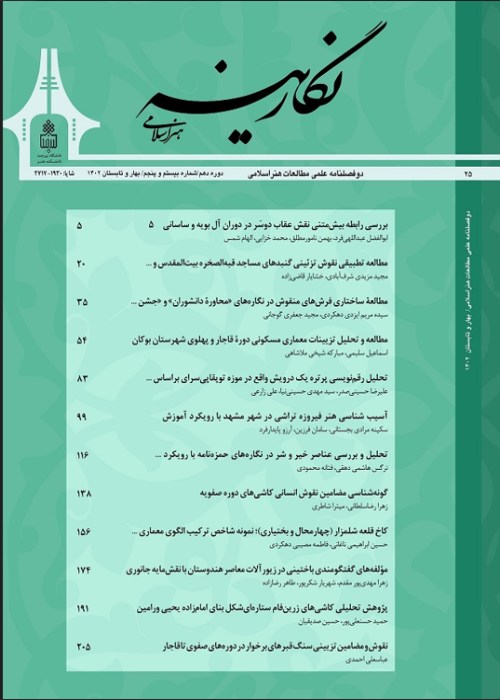A Comparative Study of the Zodiac-Man image in Iranian and Indian Paintings
Human interest in planets and stars and their role in human life and destiny dates back to thousands years ago. Astrology has had numerous effects on medical science. One of its important roles is the appearance of "zodiac-man" based on the position of planets and stars in the sky and the coincidence of its effects on human organs. "Zodiac-Man" shows the image of a human that the position of the twelve constellations and the related medical effects are marked on his body. Each of these marks determines the appropriate month and time for surgery of each organ of body or the appropriate medical treatment for patient based on his astrology. This image can be seen in medical handwritten illustrated copies or single sheets in Iran and India. The question is: What connection exists in the (chosen) paintings of Iran and India, in terms of concepts and human illustration method of the zodiac-man? According to the conducted studies in general; the style of "Zodiac-man" iconography in both paintings follows the same pattern and idea, but its processing way, has turned into native form. The research method is descriptive-comparative. Medical science is one of the sciences that combined with astrology, and the outcome of this combination can be seen in "zodiac-man". The resulting illustration of this combination in Iran and India is observable in medical or astrology books. The application of "Zodiac-man" is more in medical science, so each person has a specific fortune at birth, and based on that, one's medical affairs is done. In "Zodiac-Man", twelve constellations have drawn and organs of the body must be treated or operated based on that, so the patience regains his health. In addition to Iran and India, "Zodiac-Man" received a lot of attention in other eastern and western countries. The existence of these paintings can be considered as a map and model for philosophers and physicians who have used it to determine the time of surgery or other medical operations on the patient's body. The primary image that Jorjani drew based on the "KhwarezmShahi's book" is very simple and without details, which is due to the fact that, it influences from Mansouri's paintings and the first copy of the book "Tashrih alAbdan". This drawing is very simple and understandable that later the drawings of the zodiac are frequently drawn in Iranian books. A distinguished example of this painting can be seen in the Ottoman royal calendar. The Indian illustrated "Zodiac-Man" is based on Jorjani's illustrated "Zodiac-Man" but the only difference is in the representation of the zodiac figure. The face of human figures is an important and special point that is visible in the paintings of the Indian zodiac and indicates the Buddhist beliefs and their Indian gods. The painters of both countries, as a result of the structural concepts of their society, have designed the "Zodiac-man" and the zodiac, and it can be admitted that they have been very successful.
- حق عضویت دریافتی صرف حمایت از نشریات عضو و نگهداری، تکمیل و توسعه مگیران میشود.
- پرداخت حق اشتراک و دانلود مقالات اجازه بازنشر آن در سایر رسانههای چاپی و دیجیتال را به کاربر نمیدهد.


